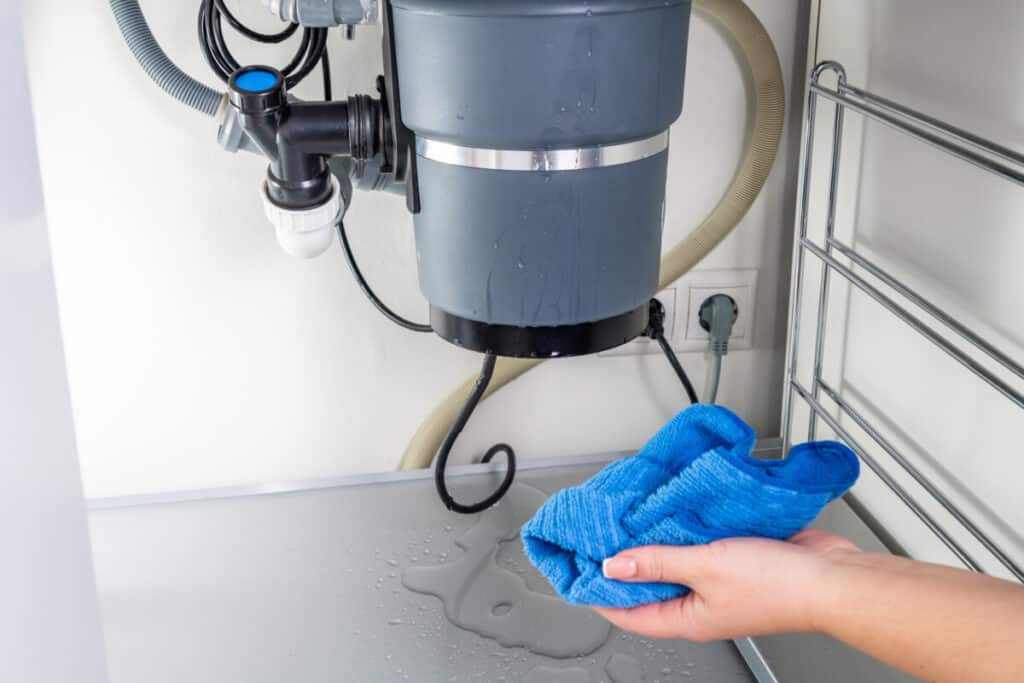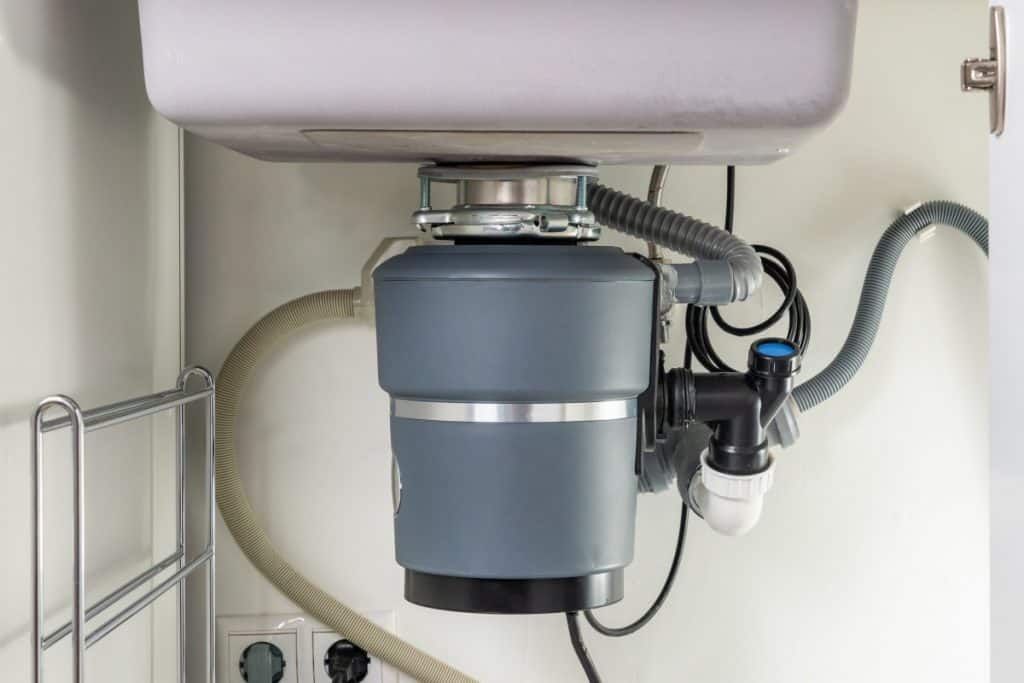
The garbage disposal is a modern invention that has made washing dishes and getting rid of waste much easier than it used to be. Unfortunately, garbage disposals are not invincible and occasionally, yours may spring a leak and need to be repaired. One question is when those inevitable leaks happen, does that mean your dishwasher will be out of commission as well?
A dishwasher can run when the garbage disposal is leaking. Although some dishwashers drain water into the garbage disposal, they can still run if the garbage disposal leaks. If the disposal leaks while the dishwasher runs, the source of the leak may be faulty pipe connectors or a worn-out flange.
Leaky disposals are never fun to deal with, but sadly, it’s something that you are likely to face at one time or another. However, things aren’t as hopeless as they seem! There are plenty of solutions for leaky disposals as well as preventative measures you can take. Read on to learn more about leaky disposals and what you can do to fix them!
Discovering the Leak
You might be thinking, I’m pretty sure I’ll know if my garbage disposal is leaking. It’s got to be pretty obvious, right? As it turns out, leaks in your garbage disposal can be hard to spot at times. Some leaks located on the side of the disposal facing the wall will be harder to spot.
However, more often than not, water might start to pool under the disposal in your cabinet. If you start to notice this happening, it is imperative that you stop using the disposal and mop up the water. If the water sits on the cabinet flooring, it will warp, stain, and eventually rot the wood.
If you have discovered that your disposal has sprung a leak, there are four different places that you should check first. These are:
- The garbage disposal body (a crack/leak in the main disposal component)
- The rubber hose connecting the dishwasher and disposal (comes out the side of the disposal)
- The sink flange (where the bottom of the sink drain and the top of the disposal connect)
- The drain pipe (another pipe, usually made of plastic or metal that drains all the water to the sewer)
Still not sure where the leak is coming from? You can locate the leak in your garbage disposal in a couple of different ways. First, use red, green, or blue food coloring to heavily dye some water. Once the water looks like a sports drink, pour it down the disposal. If all goes to plan, the coloring will stain the area where the disposal is leaking and you’ll be able to find it in no time.

If you’d rather not use food coloring, try stopping the sink and filling it with a few inches of water. Make sure you have dried the disposal off underneath the sink very thoroughly. After you have filled the sink, unplug the stopper and let the water drain out. Keep in mind that the water isn’t going to drip slowly, it’s going to spurt, so make sure you put a bucket under the sink. Watch carefully to identify where the leak is.
If your garbage disposal is leaking, you should still be able to use the dishwasher. Just make sure you do not run the disposal before you start the dishwasher. However, if the disposal is needed to drain the sink of water, using the dishwasher without running the disposal first might cause a little bit of overflow. Just be mindful of the conditions before you start it up and you should be fine.
DIY: How to fix the leak
Fixing leaks yourself is either a really good or really bad idea, depending on who you ask. Some leaks can be fixed by people with little to no plumbing experience while fixing others yourself could lead to more problems in the future. Here are a few things to know:
If the flange is the problem, that will likely be indicated by a leak on the top of the disposal. Thankfully, this is a relatively easy fix. First try to tighten the collar to see if the water stops, if not you may need to reseal the flange with new plumbers putty.
If your pipes are leaking, they either need to be tightened or replaced. Tightening the pipes can ensure fewer leakages around the pipe connections, but make sure to only hand tighten these as tools can easily break them. If the pipe has been punctured, however, it is always best to replace the pipe. If the disposal’s body is cracked, this is likely the result of people knocking and bumping into it when they retrieve items from underneath the sink. In this instance, purchasing a new disposal will probably be necessary.
Preventative Measures
As mentioned earlier, there is little you can do to prevent all leaks that might spring in your garbage disposal; however, there are preventative measures you can take to minimize the risk as much as possible. Here are a few things to consider.
First, you need to be extremely mindful about what goes down the garbage disposal because that could mean the difference between whether it keeps working or not. For instance, bones, grease, meat, or anything similar will clog the disposal. If you were to put bones or gristle down there, it’s possible that certain fragments could be hard enough to bust a leak on their own.
You should also be careful to avoid fibrous vegetables, coffee grounds, or eggshells. Some might say that eggshells are a great tool to sharpen your disposal’s impellers, but this is only half true. Yes, you could grind up one or two shells at a time without any major issues, but it’s not a practice most would recommend.

Additionally, you’ll need to keep your disposal as clean as possible. This will prevent unnecessary wear and tear, plus you’ll sleep more soundly knowing there is nothing in the disposal that could cause damage. One way to do this is to grind up a few ice cubes and some salt. Ice will both scour and rinse the impellers, making them sharp enough to do their job.
You can also try using vinegar and baking soda. Pour a few tablespoons of baking soda down the drain and let it sit for a moment. Once you’ve left it for about ten minutes, pour in some vinegar and let it bubble and fizz for a moment. Once you’re satisfied, rinse the whole thing thoroughly with hot water and run the disposal for a moment or two.
Lastly, consider using under cabinet trays to contain any leaking water and prevent further damage to your cabinet. These come in all common cabinet sizes and there are also universal ones that can be cut to size. I can not recommend these enough as they have personally saved me two times now.
Dishwasher maintenance
Taking care of the dishwasher is just as important as taking care of the garbage disposal. Careful maintenance of both appliances will result in longer life expectancy.
Thoroughly scrape and rinse your dishes before putting them in the washer. Failure to do so will eventually result in clogged drainage pipes and that can cause flooding and sometimes leaks.
One of the most common and irritating issues with a dishwasher is the smell. If not used and cleaned properly, it is likely your dishwasher will develop a pretty nasty odor from bacteria and waste buildup. This can be remedied in various ways. One option is to run the dishwasher through a cycle with vinegar, lemon juice, or another acid.
Running the dishwasher with one of these will remove the buildup and get rid of the stench. In severe cases involving mildew or mold, consider using bleach. However, DO NOT use bleach if your washer has a stainless steel door or interior.
If your dishwasher is leaking, consider checking the door, tub, and valves. A leaky door could very well be the source of the problem. This is an easy fix so be sure to check for that first. Also, check your drain hoses to make sure they are properly tightened and leak free. In severe cases, professional help will probably be required, which is okay. Just try to find the source of the problem first before you run up a large repair bill.
Related Topics:
If you like the article above, here are some other similar articles you should check out!
How Do You Clean Garbage Disposals? | A Care Guide
